Preparation and Tribological Properties of Modified MoS2/SiC/Epoxy Composites
Abstract
1. Introduction
2. Materials and Methods
2.1. Materials
2.2. Preparation of KH560-MoS2
2.3. Composites Preparation
2.4. Measurement and Characterization
3. Results and Discussion
3.1. Characterization on The Modification of MoS2 Powder by KH560
3.2. Dispersion of High Content of Modified MoS2/SiC in Epoxy Matrix
3.3. Tribological Properties of Composites
3.4. Wear Mechanism Analysis of Composites
4. Conclusions
- (1)
- The results of TGA, Raman and XPS showed that the surface of MoS2 particles was successfully modified by KH560.
- (2)
- It is found that the friction and wear properties of SiC/EP composites with MoS2 are better than those without MoS2. When the adding fraction of modified MoS2 is 4 wt.%, the friction coefficient and volume wear rate of EP composites are lowest. Compared with 55 wt.% SiC/EP composite, the friction coefficient and volume wear rate of the SiC/EP composite containing 4 wt.% MoS2 are reduced by 10.06% and 52.13%, respectively. Furthermore, the composite friction coefficient is decreased by about 16.14%, from 0.533 to 0.447, and the volume wear rate is reduced by 92.84%, from 200.98 × 10−5 mm3/N·m to 14.39 × 10−5 mm3/N·m, in comparison with those of pure EP, proving the significant improvement of wear resistance of EP composites.
- (3)
- When the appropriate content of MoS2 with lubricating properties is added, the MoS2 homogenously dispersed in the material gradually migrates to the surface during the friction process to form the lubricating film, so as to make the worn surface smoother. However, when the weak-bonded MoS2 content increased to 5 wt.%, some hard abrasive SiC particles existed on the wear surface, resulting in slight abrasive wear, which increased the friction coefficient and volume wear rate. In addition, if the load increases and exceeds the capacity of the modified MoS2/SiC/EP composite, the lubricant film is partially destroyed, and the main wear mechanism is fatigue wear.
Author Contributions
Funding
Institutional Review Board Statement
Informed Consent Statement
Data Availability Statement
Conflicts of Interest
References
- Ahmadi-Khaneghah, A.; Omidi-Ghallemohamadi, M.; Behniafar, H. PEG-based epoxy and epoxy/silica networks: Thermal, mechanical, and thermo-mechanical investigations. Int. J. Adhes. Adhes. 2019, 95, 102430. [Google Scholar] [CrossRef]
- Guo, Q.B.; Lau, K.T.; Rong, M.Z.; Zhang, M.Q. Optimization of tribological and mechanical properties of epoxy through hybrid filling. Wear 2010, 269, 13–20. [Google Scholar] [CrossRef]
- Hwang, Y.; Kim, M.; Kim, J. Fabrication of surface-treated SiC/epoxy composites through a wetting method for enhanced thermal and mechanical properties. Chem. Eng. J. 2014, 246, 229–237. [Google Scholar] [CrossRef]
- Abenojar, J.; Tutor, J.; Ballesteros, Y.; Real, J.C.; Martinez, M.A. Erosion-wear, mechanical and thermal properties of silica filled epoxy nanocomposites. Compos. Part B 2017, 120, 42–53. [Google Scholar] [CrossRef]
- Yasmin, A.; Daniel, I.M. Mechanical and thermal properties of graphite platelet/epoxy composites. Polymer 2004, 45, 8211–8219. [Google Scholar] [CrossRef]
- Dasari, A.; Yu, Z.Z.; Mai, Y.W. Fundamental aspects and recent progress on wear/scratch damage in polymer nanocomposites. Mater. Sci. Eng. R. 2009, 63, 31–80. [Google Scholar] [CrossRef]
- Shen, X.J.; Pei, X.Q.; Liu, Y.; Fu, S.Y. Tribological performance of carbon nanotube-graphene oxide hybrid/epoxy composites. Compos. Part B 2014, 57, 120–125. [Google Scholar] [CrossRef]
- Baptista, R.; Mendão, A.; Rodrigues, F.; Figueiredo-Pina, C.G.; Guedes, M.; Marat-Mendes, R. Effect of high graphite filler contents on the mechanical and tribological failure behavior of epoxy matrix composites. Theor. Appl. Fract. Mech. 2016, 85, 113–124. [Google Scholar] [CrossRef]
- Basavarajappa, S.; Ellangovan, S. Dry sliding wear characteristics of glass-epoxy composite filled with silicon carbide and graphite particles. Wear 2012, 296, 491–496. [Google Scholar] [CrossRef]
- Xian, G.J.; Walter, R.; Haupert, F. A synergistic effect of nano-TiO2 and graphite on the tribological performance of epoxy matrix composites. J. Appl. Polym. Sci. 2006, 102, 2391–2400. [Google Scholar] [CrossRef]
- Nhuapeng, W.; Thamjaree, W.; Kumfu, S.; Singjai, P.; Tunkasiri, T. Fabrication and mechanical properties of silicon carbide nanowires/epoxy resin composites. Curr. Appl. Phys. 2008, 8, 295–299. [Google Scholar] [CrossRef]
- Chisholm, N.; Mahfuz, H.; Rangari, V.K.; Ashfaq, A.; Jeelani, S. Fabrication and mechanical characterization of carbon/SiC-epoxy nanocomposites. Compos. Struct. 2005, 67, 115–124. [Google Scholar] [CrossRef]
- Zhou, T.L.; Wang, X.; Gu, M.Y.; Xiong, D.S. Study on Mechanical, Thermal and Electrical Characterizations of Nano-SiC/Epoxy Composites. Polym. J. 2009, 41, 51–57. [Google Scholar] [CrossRef]
- Kumar, V.; Monika; Lee, D.J. High-actuation displacement with high flexibility for silicone rubber and few layer graphene composites. Sens. Actuators A. 2020, 309, 111956. [Google Scholar] [CrossRef]
- Kumar, V.; Lee, G.; Singh, K.; Choi, J.; Lee, D.J. Structure-property relationship in silicone rubber nanocomposites reinforced with carbon nanomaterials for sensors and actuators. Sens. Actuators A. 2020, 303, 111712. [Google Scholar] [CrossRef]
- Kumar, V.; Alam, M.N.; Manikkavel, A.; Choi, J.; Lee, D.J. Investigation of silicone rubber composites reinforced with carbon nanotube, nanographite, their hybrid and applications for flexible devices. J. Vinyl. Addit. Technol. 2020, 1–10. [Google Scholar] [CrossRef]
- Chen, B.; Ni, B.J.; Liu, W.T.; Ye, Q.Y.; Liu, S.Y.; Zhang, H.X.; Yoon, K.B. Mechanical properties of epoxy nanocomposites filled with melamine functionalized molybdenum disulfide. RSC Adv. 2018, 8, 20450–20455. [Google Scholar] [CrossRef]
- Pettarin, V.; Churruca, M.J.; Felhs, D.; Karger-kocsis, J.; Frontini, P.M. Changes in tribological performance of high molecular weight high density polyethylene induced by the addition of molybdenum disulphide particles. Wear 2010, 269, 31–45. [Google Scholar] [CrossRef]
- Alajmi, M.; Alrashdan, K.R.; Alsaeed, T.; Shalwan, A. Tribological characteristics of graphite epoxy composites using adhesive wear experiments. J. Mater. Res. Technol. 2020, 9, 13671–13681. [Google Scholar] [CrossRef]
- Raj, V.R.; Ramnath, B.V. Mechanical, Thermal and Wear Behavior of SiC Particle Strengthening of PMMA-Toughened Glass-Epoxy Hybrid Composite. Silicon 2020. [Google Scholar] [CrossRef]
- Dass, K.; Chauhan, S.R.; Gaur, B. Evaluation of Mechanical, Friction, and Wear Characteristics of Nano-SiC Filled Ortho Cresol Novalac Epoxy Composites under Dry Sliding Condition. Adv. Polym. Technol. 2015, 34. [Google Scholar] [CrossRef]
- Bhagyashekar, M.S.; Rao, R.M.V.G.K. Effects of Material and Test Parameters on the Wear Behavior of Particulate Filled Composites Part 1: SiC-Epoxy and Gr-Epoxy Composites. J. Reinf. Plast. Compos. 2007, 26, 1753–1768. [Google Scholar] [CrossRef]
- Sudheer, M.; Karthik, M.N.; Kewin, A.M.; Jonthan, B.; Mayur, J.K. Mechanical and Abrasive Wear Behavior of Metal Sulphide Lubricant Filled Epoxy Composites. ISRN Polym. Sci. 2013, 1–8. [Google Scholar] [CrossRef][Green Version]
- Srivastava, S.K.; Sahoo, A.K.; Bindumadhavan, K.; Manu, S.K.; Nayak, B.B.; Biswas, K.; Saxena, A.K.; Singh, R. Reinforcement of ball shaped MoS2 nanoparticles in epoxy resin. J. Nanosci. Nanotechnol. 2010, 10, 8171. [Google Scholar] [CrossRef]
- Li, Y.C.; Wang, Z.Y.; Zhan, Y.H.; Wang, S.S.; Tao, X.Q.; Liao, C.Z.; Lu, Z.G. Improved Mechanical and Dielectric Performances of Epoxy Nanocomposites Filled with Aminated Polyethylene Glycol Grafted Graphene. Mater. Lett. 2019, 246, 149–152. [Google Scholar] [CrossRef]
- Shang, X.J.; Zhu, Y.M.; Li, Z.H. Surface modification of silicon carbide with silane coupling agent and hexadecyl iodiele. Appl. Surf. Sci. 2017, 394, 169–177. [Google Scholar] [CrossRef]
- Gu, J.W.; Zhang, Q.Y.; Dang, J.; Zhang, J.P.; Chen, S.J. Preparation and mechanical properties researches of silane coupling reagent modified β-silicon carbide filled epoxy composites. Polym. Bull. 2009, 62, 689–697. [Google Scholar] [CrossRef]
- He, Y.; Chen, Z.C.; Ma, L.X. Thermal Conductivity and Mechanical Properties of Silicone Rubber Filled with Different Particle Sized SiC. Adv. Mater. Res. 2010, 87–88, 137–142. [Google Scholar] [CrossRef]
- Li, H.; Zhang, Q.; Yap, C.C.R.; Tay, B.K.; Edwin, T.H.T.; Olivier, A.; Baillargeat, D. From Bulk to Monolayer MoS2: Evolution of Raman Scattering. Adv. Funct. Mater. 2012, 22, 1385–1390. [Google Scholar] [CrossRef]
- Wang, D.; Wen, P.Y.; Wang, J.; Song, L.; Hu, Y. The effect of defect-rich molybdenum disulfide nanosheets with phosphorus, nitrogen and silicon elements on mechanical, thermal, and fire behaviors of unsaturated polyester composites. Chem. Eng. J. 2017, 313, 238–249. [Google Scholar] [CrossRef]
- Wang, M.Y.; Ma, L.C.; Shi, L.L.; Feng, P.F.; Wang, X.J.; Zhu, Y.Y.; Wu, G.S.; Song, G.J. Chemical grafting of nano-SiO2 onto graphene oxide via thiol-ene click chemistry and its effect on the interfacial and mechanical properties of GO/epoxy composites. Compos. Sci. Technol. 2019, 182, 107751. [Google Scholar] [CrossRef]
- Jing, Y.J.; Wang, P.Q.; Yang, Q.B.; He, Y.; Bai, Y. The effect of a functionalized defect-rich molybdenum disulfide nanosheets on anticorrosion performance of epoxy coating. Mater. Res. Express. 2019, 6, 86473. [Google Scholar] [CrossRef]
- Rangarajan, S.; Aswath, P.B. Role of precursor chemistry on synthesis of Si-O-C and Si-O-C-N ceramics by polymer pyrolysis. J. Mater. Sci. 2011, 46, 2201–2211. [Google Scholar] [CrossRef]
- Kelemen, S.R.; Afeworki, M.; Gorbaty, M.L.; Cohen, A.D. Characterization of Organically Bound Oxygen Forms in Lignites, Peats, and Pyrolyzed Peats by X-ray Photoelectron Spectroscopy (XPS) and Solid-State 13C NMR Methods. Energy Fuels. 2002, 16, 1450–1462. [Google Scholar] [CrossRef]
- Zhou, K.Q.; Gao, R.; Qian, X.D. Self-assembly of exfoliated molybdenum disulfide (MoS2) nanosheets and layered double hydroxide (LDH): Towards reducing fire hazards of epoxy. J. Hazard. Mater. 2017, 338, 343–355. [Google Scholar] [CrossRef]
- Jiao, W.Z.; Liu, Y.Z.; Qi, G.S. Studies on mechanical properties of epoxy composites filled with the grafted particles PGMA/Al2O3. Compos. Sci. Technol. 2009, 69, 391–395. [Google Scholar] [CrossRef]
- Belon, C.; Schmitt, M.; Bistac, S.; Croutxé-Barghorn, C.; Chemtob, A. Friction and wear properties of hybrid sol-gel nanocomposite coatings against steel: Influence of their intrinsic properties. Appl. Surf. Sci. 2011, 257, 6618–6625. [Google Scholar] [CrossRef]
- Luo, Y.; Rong, M.Z.; Zhang, M.Q. Tribological behavior of epoxy composites containing reactive SiC nanoparticles. J. Appl. Polym. Sci. 2007, 104, 2608–2619. [Google Scholar] [CrossRef]
- Durand, J.M.; Vardavoulias, M.; Jeandin, M. Role of reinforcing ceramic particles in the wear behaviour of polymer-based model composites. Wear 1995, 181–183, 833–839. [Google Scholar] [CrossRef]
- Jiang, Y.M.; Liu, K.; Tang, X.K.; Li, Z.S. Preparation and properties of epoxy composite reinforced with SiC. J. Synth. Cryst. 2018, 47, 197–202. [Google Scholar]
- Zalaznik, M.; Novak, S.; Huski, M.; Kalin, M. Tribological behaviour of a PEEK polymer containing solid MoS2 lubricants. Lubri. Sci. 2016, 28, 27–42. [Google Scholar] [CrossRef]
- Hao, Y.; Zhou, X.Y.; Shao, J.J.; Zhu, Y.K. The influence of multiple fillers on friction and wear behavior of epoxy composite coatings. Surf. Coat. Technol. 2019, 362, 213–219. [Google Scholar] [CrossRef]
- Liu, Z.; Jia, Y.; Zhao, C.B.; Han, M.; Yang, J.X. Preparation of modified MoS2/bismaleimide resin and research on its properties. China Molybdenum Ind. 2019, 43, 37–40. [Google Scholar]
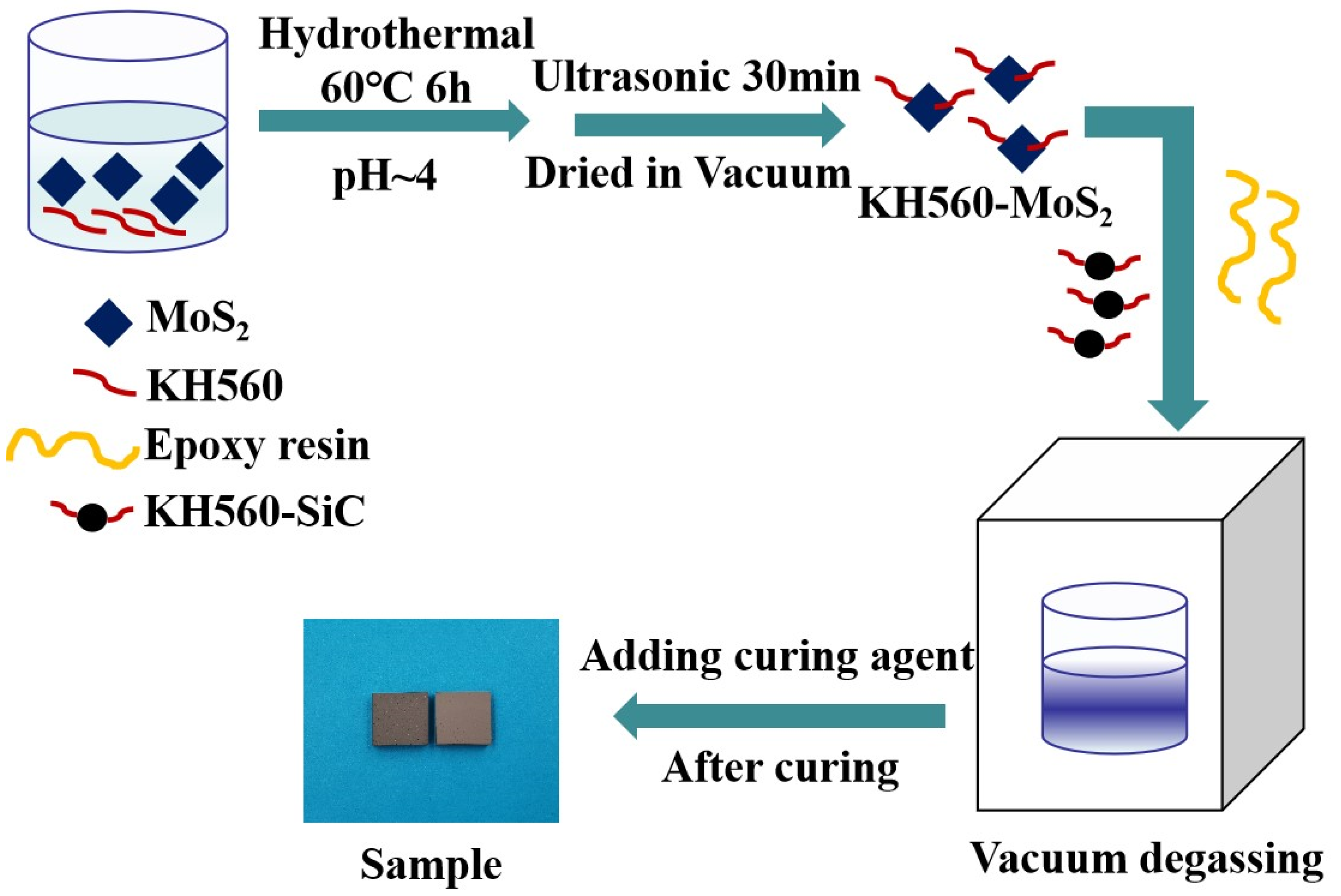


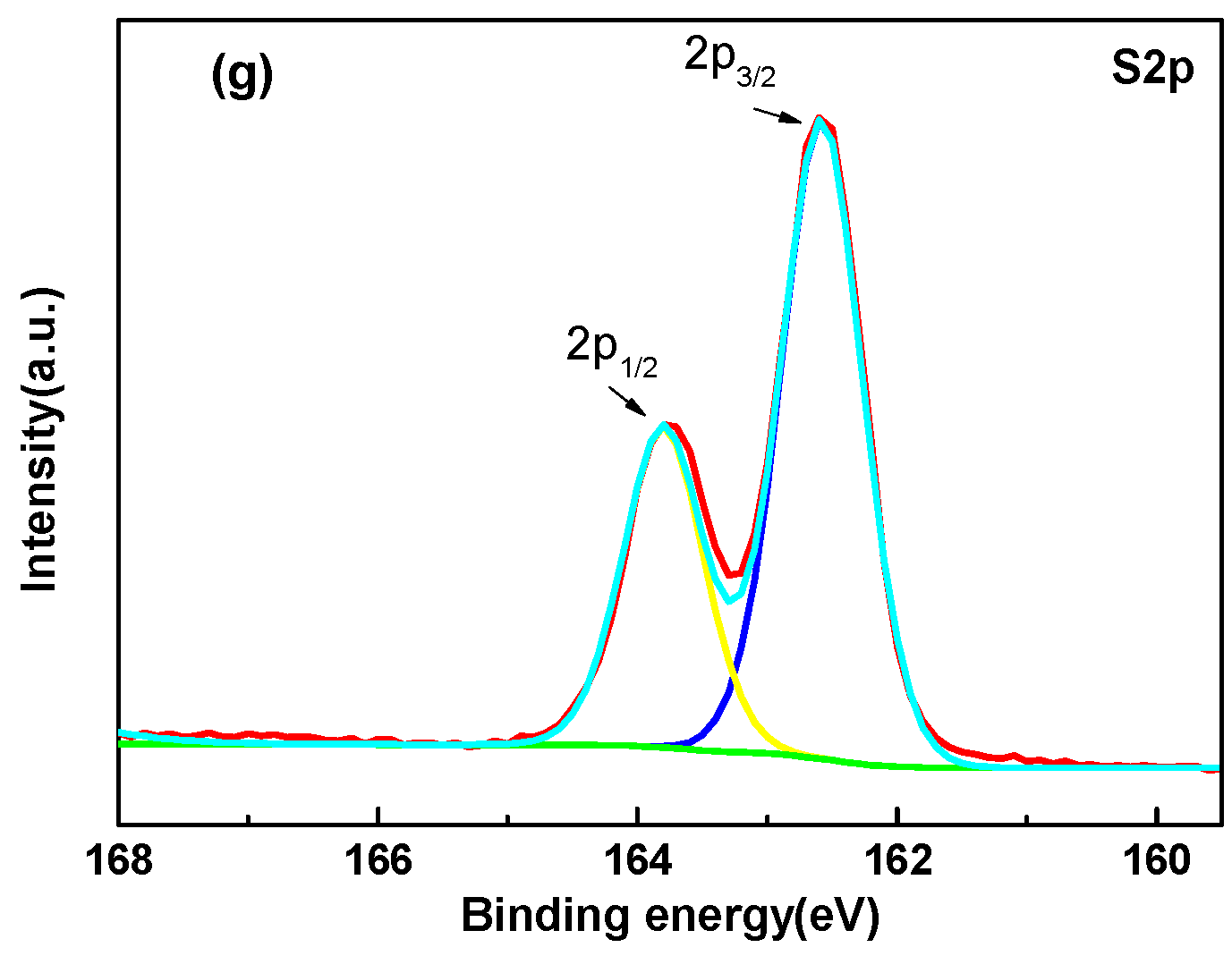
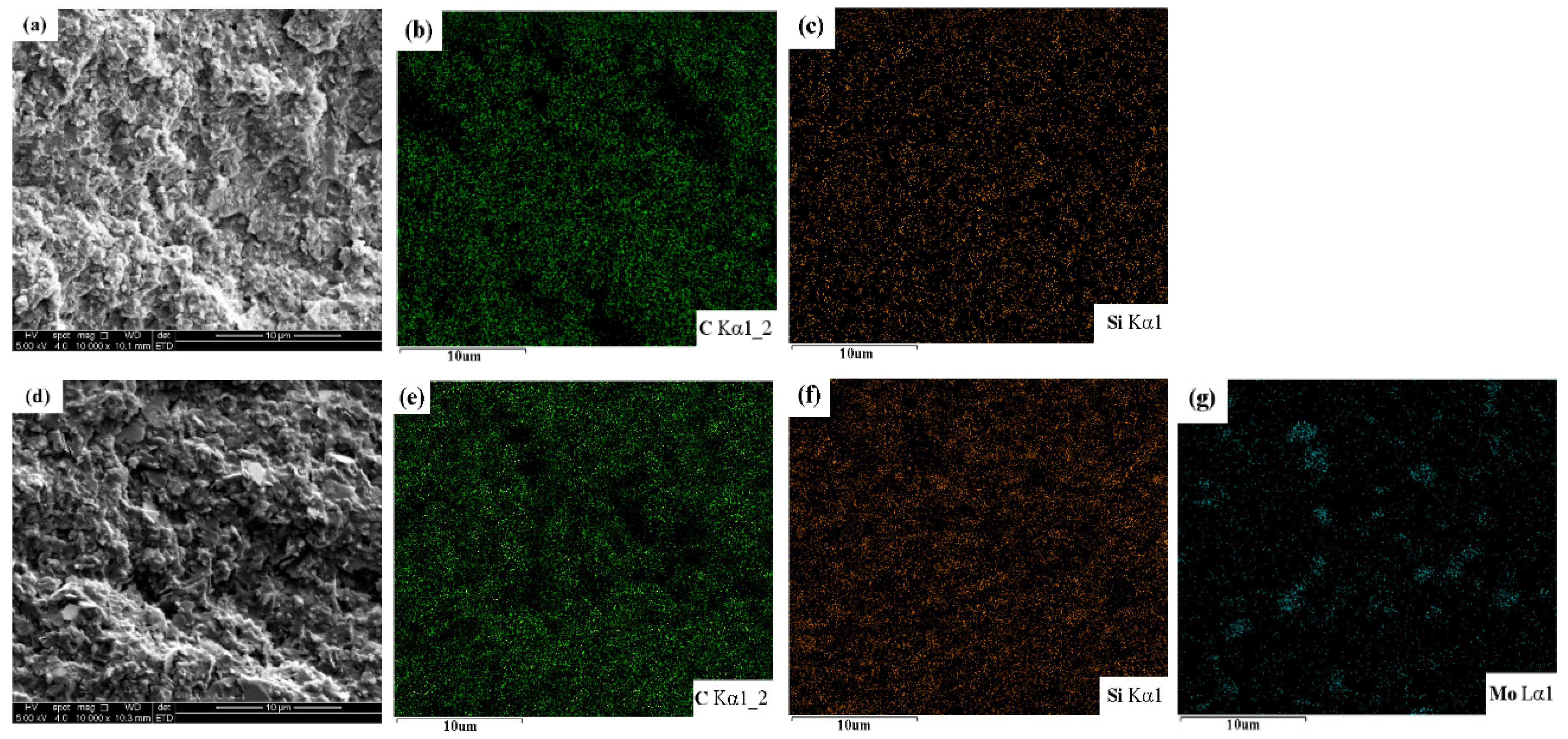
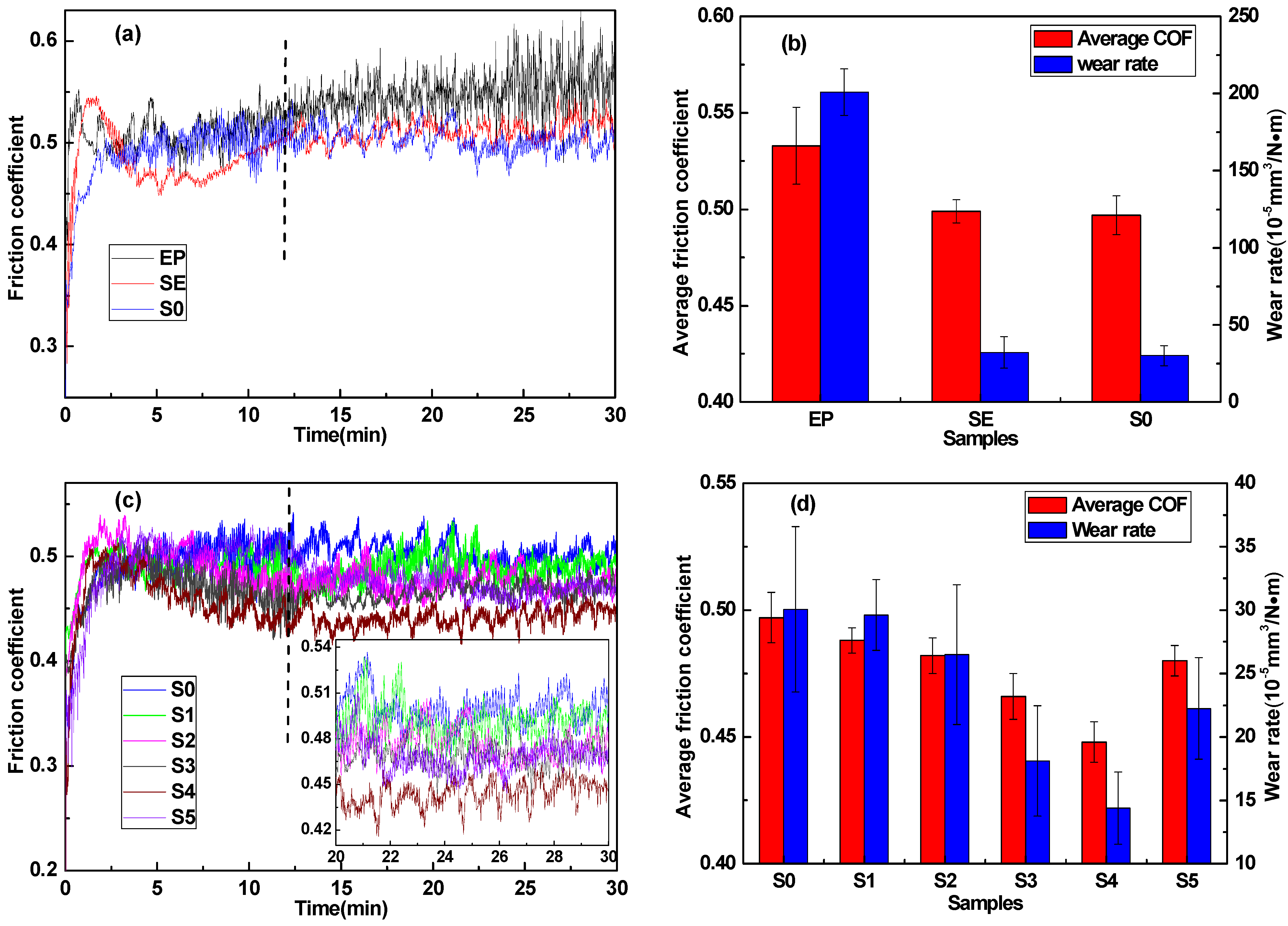
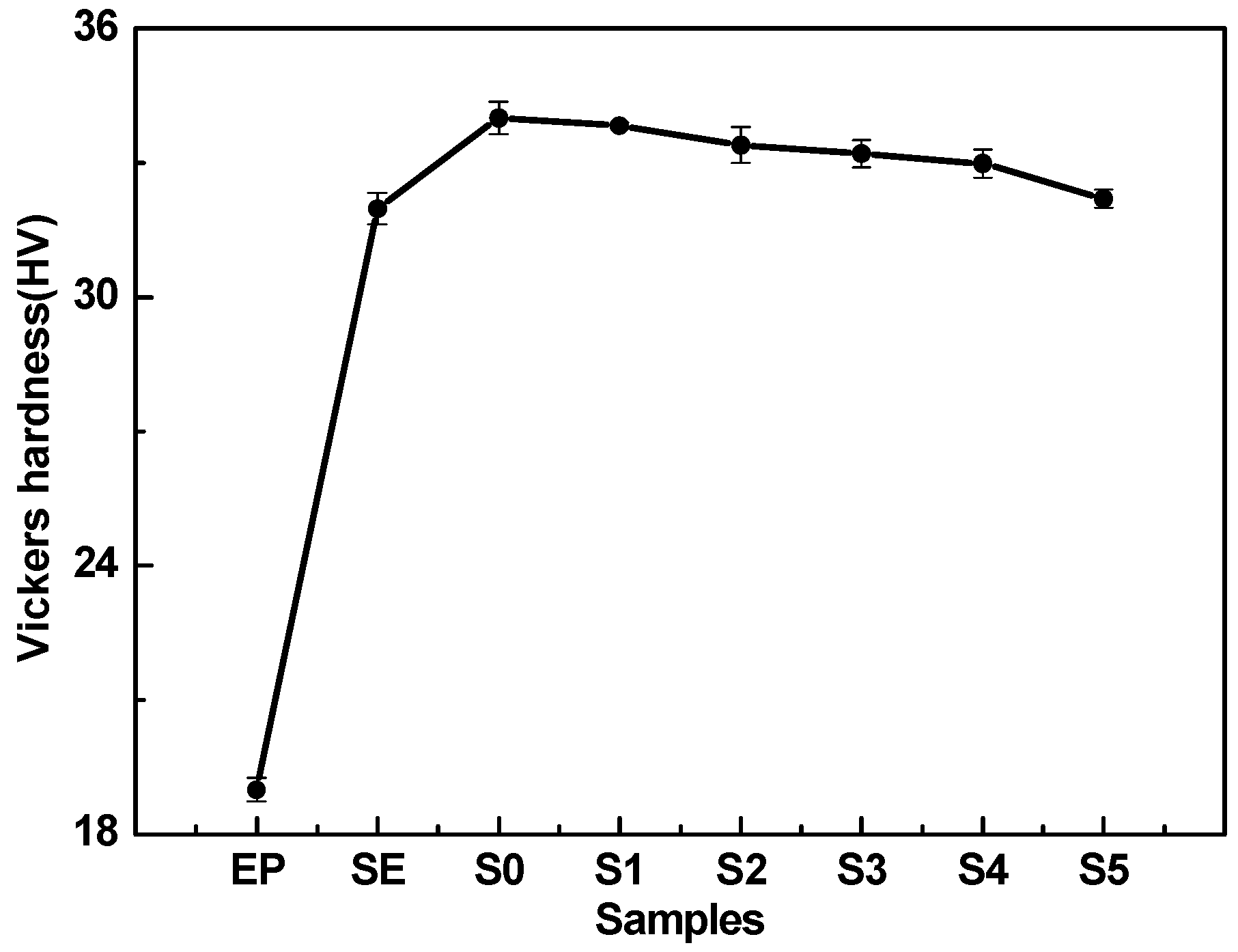
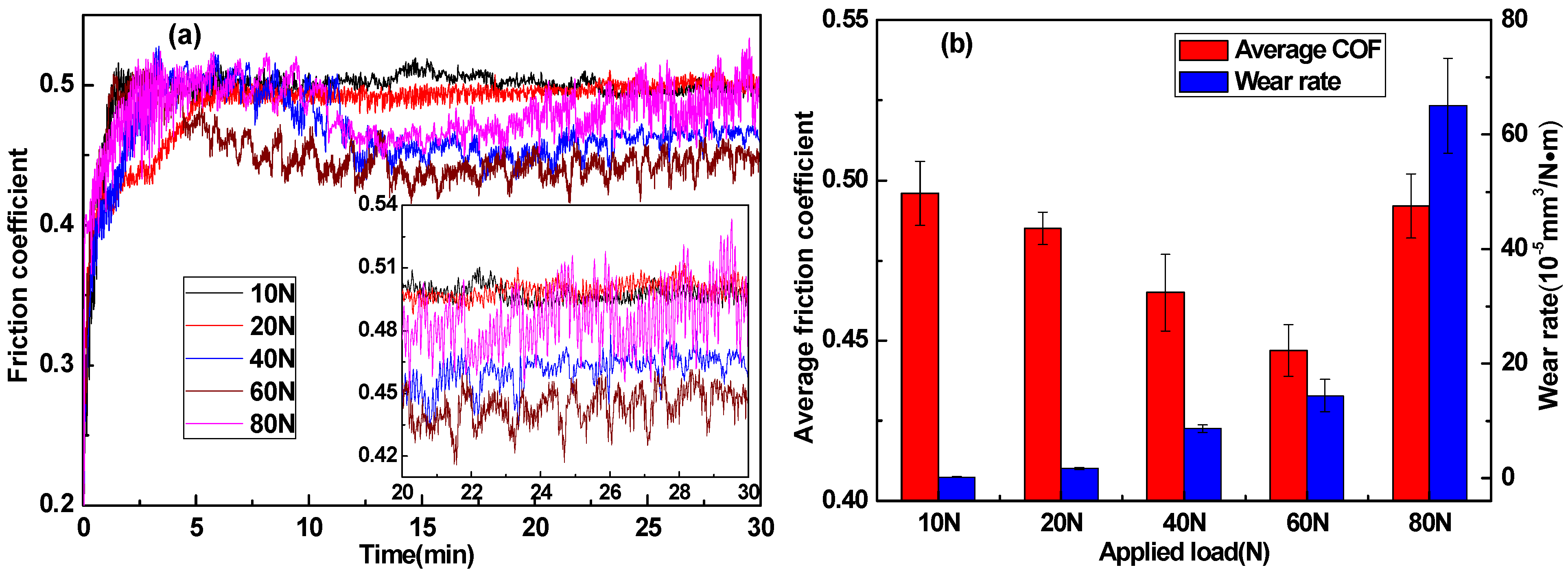

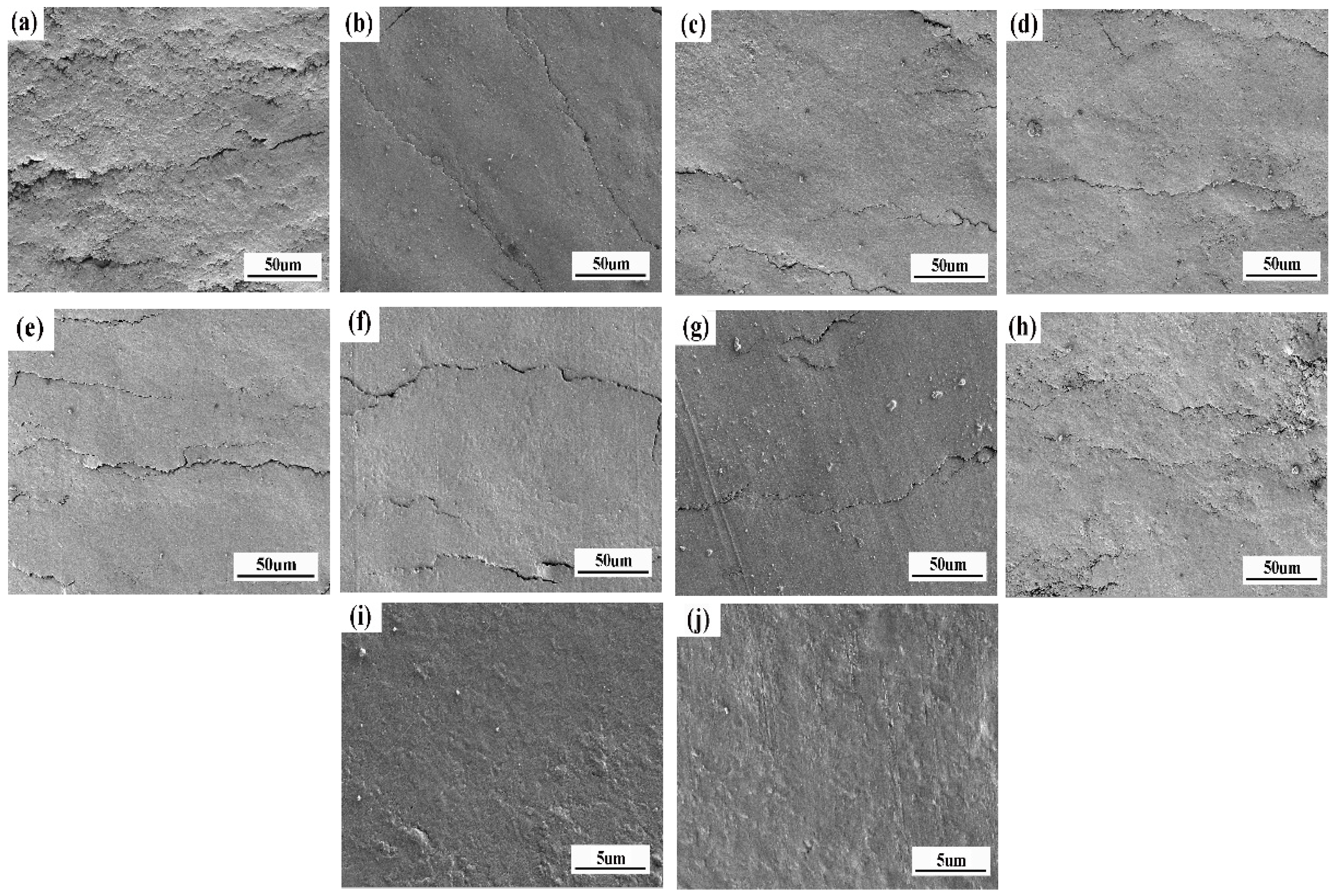
| Sample | Fillers (wt.%) | EP (wt.%) | |
|---|---|---|---|
| SiC | MoS2 | ||
| EP | 0 | 0 | 100 |
| SE | 50 | 0 | 50 |
| S0 | 55 | 0 | 45 |
| S1 | 54 | 1 | 45 |
| S2 | 53 | 2 | 45 |
| S3 | 52 | 3 | 45 |
| S4 | 51 | 4 | 45 |
| S5 | 50 | 5 | 45 |
Publisher’s Note: MDPI stays neutral with regard to jurisdictional claims in published maps and institutional affiliations. |
© 2021 by the authors. Licensee MDPI, Basel, Switzerland. This article is an open access article distributed under the terms and conditions of the Creative Commons Attribution (CC BY) license (https://creativecommons.org/licenses/by/4.0/).
Share and Cite
Liu, C.; Li, M.; Shen, Q.; Chen, H. Preparation and Tribological Properties of Modified MoS2/SiC/Epoxy Composites. Materials 2021, 14, 1731. https://doi.org/10.3390/ma14071731
Liu C, Li M, Shen Q, Chen H. Preparation and Tribological Properties of Modified MoS2/SiC/Epoxy Composites. Materials. 2021; 14(7):1731. https://doi.org/10.3390/ma14071731
Chicago/Turabian StyleLiu, Cheng, Meijuan Li, Qiang Shen, and Haikun Chen. 2021. "Preparation and Tribological Properties of Modified MoS2/SiC/Epoxy Composites" Materials 14, no. 7: 1731. https://doi.org/10.3390/ma14071731
APA StyleLiu, C., Li, M., Shen, Q., & Chen, H. (2021). Preparation and Tribological Properties of Modified MoS2/SiC/Epoxy Composites. Materials, 14(7), 1731. https://doi.org/10.3390/ma14071731





